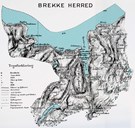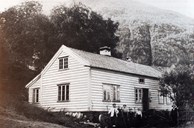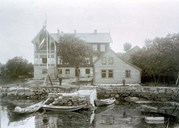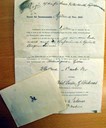The municipality of Gulen in 1905
In 1905, the present municipality of Gulen consisted of the municipalities of Gulen and Brekke. The island of Losna belonged to Gulen. In 1905, the municipality consisted of the main parish of Gulen and the annexe parish of Mjømna.
Lavik and Brekke were divided by royal decree on 1 October 1904, effective as of 1 January 1905. Lavik and Brekke still constituted one bailiff's district. Brekke was still a part of Lavik parish after the division of the municipalities.

In 1900, the population of Gulen municipality was 3254. Fishery was an important industry, especially the lobster and salmon fisheries. The municipality had one savings bank (Eivindvik sparebank). Other industrial activities included Selvåg clog factory, the margarine factory at Fonnevik, and the sawmills at Eidssagen and Dingja. The total length of roads in 1901 was 12 kilometres.
In 1910, the population of Brekke municipality numbered 951. (We do not have the figure for 1900.) There were better conditions for agriculture in Brekke than in Gulen, and potatoes were an important crop. The inhabitants of Brekke were also involved in the coastal fisheries, but not to the same extent as in Gulen. There were few driveable roads in Brekke in 1905, but there was a road between Brekke and Verkland as well as between Brekke and Takle.
In 1905, three new sub-post offices were established in Gulen (Dalsøyra, Gulafjord and Nordgulen). Six other offices had been established before: (Guløy, Mjømna, Skjerhamn, Sygnefest, Eivindvik and Halsvik). In Brekke there were three sub-post offices (Brekke, Vikum and Bålen). There were long-distance telephone exchanges in Gulen, three of these established in 1904 and one in 1905 (Dalsøyra, Leversund, Eivindvik (1904), and Nyborg (1905)). The steamship company "Fylkesbaatane" had stops at Brekke, Bålen and Oppedal in the Brekke municipality, and Mjømna, Skjerjehamn, Guløy (Nyborg), Eivindvik, Dingja and Sygnefest in the Gulen municipality.
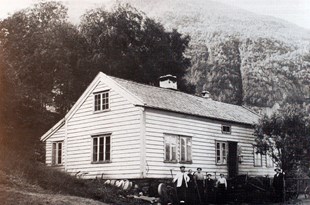
"In excited anticipation"
At a time without mobile phones, internet, radio and TV, people heard news in other ways. They "asked for news" whenever and wherever they met - by the quayside, in the shop, at school, at church (in the form of announcements from the church door), as well as through the post (letters and newspapers).
We also find examples that people were particularly interested in everything that was Norwegian. A letter printed in the local paper "Sogns Tidende" on 12 February deals with the typical folk instrument - the Hardanger fiddle. The writer of the letter - Einar Ynnesdal - writes that he "loves the fiddle more than any other musical instrument. It is very beautiful and more Norwegian than the accordion". He continues, writing "that Ole Bull has learnt to play by listening to the melodious tunes of rivers I believe firmly, and this play must surely be Norwegian, must it not? Therefore, youths, make an effort to re-introduce the old Hardanger fiddle play, let the fiddle sound freely in the Norwegian valleys and towns to spread joy and happiness to old and young alike."
Other issues and events than the dissolution of the union
The dissolution of the union was obviously the big issue throughout 1905, but other issues caught the attention of people that year as well. The language issue - the work to get more people to use the "nynorsk" variety of the Norwegian language - was a burning issue, as was the emigration to America. Building a railway line to Sogn was another topical issue. The Bergen Railway was under construction, and in 1905, the first train drove through the Gravhals tunnel. The question of a side railway down to Flåm was brought up. Another important issue was the health service in the county.
Newspapers filed short or long reports all the time about big and small events throughout the county, elsewhere in the country as well as abroad.
At Brekke, in the summer of 1905, an eagle caused some problems for the inhabitants. The local paper "Sogns Tidende" wrote on 21 July that "at Brekke an eagle has had its kingdom lately and reigned with Russian power and might. From its nest up in the mountainside it has swooped down and caught a lamb, a kid, and other animals whenever it felt like it." The paper also reported that they had tried to organize an action to remove the eagle's nest. After the nest with eaglets had been removed, the eagle did not bother the inhabitants of Brekke any more.
In a short article in "Sogns Tidende" of 26 May 1905, we could read about the "Cattle fair at Lavik". Two farmers from Brekke and one from Gulen got honourable mention for their cattle. The name of the animal belonging to T. Asheim from Brekke was "Kong Oscar" (the name of the Swedish-Norwegian king). If there was a deeper meaning behind the choice of name, we do not unfortunately know.
Some prominent persons
There was a municipal election in 1904, and in the Gulen municipality A. Hantveit was elected mayor. O.K. Ottesen was vicar. Augustin Bredvik was bailiff. In the Brekke municipality Johs. L. Wergeland was elected mayor. P.H.B. Borch was vicar, whereas Lasse Ellingsen was bailiff. Ellingsen had previously been mayor of Lavik and Brekke and had also represented the county of Sogn of Fjordane at the Storting (Parliament).

Gulen municipal had a parliamentary representative in 1905, Otto Schreuder. Schreuder ran a general store at Skjerjehamn. He was an enterprising man and started an export business of salmon and lobster, which was of great importance for local fishermen throughout western Sogn. He also took part in establishing a major timber business, as well as being one of the persons behind the establishment of the savings bank "Gulen Sparebank".
Associations and organizations
In the municipality of Gulen the youth association "Fridom" was established before 1905, and probably a number of youth associations and rifle clubs.
17 May 1905
There was a massive turnout for the 17 May celebration in 1905. Throughout the country, speakers brought up the issue of Eidsvoll and the Constitution and national independence with more solemnity and more enthusiasm than ever before.
"Sogns Tidende" filed a report on 23 May on the 17 May celebration at Vadheim: "He [district doctor R. Bergh] gave an emotional and beautiful account of Norway's progress since 1814, and emphasized strongly the Norwegian demands for our rights and independence." Similar reports were written from a number of villages in the county, and there is reason to believe that Gulen also focussed on Norway's "demands for our rights and independence" at the 17 May celebration in 1905.
7 June 1905
7 June 1905, the very day that the union with Sweden was dissolved, was an ordinary working day (Wednesday), but people all around the country waited in excited anticipation for the latest news from the capital and the Storting. As the news spread, people hoisted flags, and in some places, telegrams were sent to the authorities to show their support and appreciation. The Storting issued a proclamation on the dissolution of the union. The Ministry of Church Affairs sent an appeal to the vicars, asking them to read an announcement in the churches on the following Sunday - Whit Sunday - on 11 June, or later.
On Whit Sunday a prayer was held at the Gulen church for the mother country. In a circular from the Ministry of Church Affairs vicars were asked to read a special prayer to express people's gratitude for all the events in 1905. "Keep, O God and Father, Your blessing hand over our dear country. We ask for peace from You, strength and light from Your spirit over our dear king. Make him a blessing for our people and tie his heart and ours together in mutual confidence and love. Let Your grace and blessing rest over our queen and our crown prince, and may the royal house always find happiness and strength in You."
The referendums - the right to vote and election committees
There were two referendums in 1905:
Sunday 12 and Monday 13 November when people were asked to vote 'yes' or 'no' to whether the Storting should choose a king. In reality, this was a choice between monarchy and republic.
The then municipality of Gulen constituted the Gulen election district. The election committee was made up by the following men: bailiff A. Bredvik (chairman), A. Hantveit, Otto J. Midtun, Henrik H. Tveit, Hans K. Rutledal, John J. Kjellevold and Jetmund O. Grimen. (For the November referendum Mons J. Dale met as deputy for John J. Kjellevold.)
The municipality of Brekke was a part of the Lavik election district which comprised the then municipalities of Lavik, Kyrkjebø and Brekke. The following men sat on the election committee: mayor Lasse Trædal (chairman), acting bailiff Bjørnethun, L. Aven, Johannes B. Mølmesdal, Ramsli, Berge Instefjord (August), Gunnar Mjelsvik (August), Johs. Vergeland, Johan Kirkebø, I. P. Haugland, Ivar O. Asheim, Ole Føsund (August), Sjur Dale, J. Breivik, L. Austrheim (November), A.O. Hovland (November) and Isak Tynning (November).
In the November referendum the Gulen election district had two polling stations:
a) at Gulen church and b) at Mjømna church. In the August referendum there was only one polling station at Gulen church. The counting of votes for both referendums took place at Gulen church.
In both referendums there were three polling stations for the Lavik election district: a) at Lavik church, b) at Brekke church and c) at Kykjebø church. The counting of votes took place at Lavik.
The August referendum - 'yes' or 'no' to the dissolution of the union
The result for the Gulen election district: Of the 667 who had the right to vote, 575 voted (86.2%). Everybody voted 'yes'.
The result for the Lavik election district: Of the 806 who had the right to vote, 745 voted (92.43%). Everybody voted 'yes'.
The result for the Brekke "sokn": Of the 200 who had the right to vote, 189 voted (94.5%). Everybody voted 'yes'.
In the whole county of Sogn og Fjordane the turnout was 88.7% and only three voted 'no'.
The result for the county of Sogn og Fjordane: 16 819 had the right to vote. 16, 718 accepted votes were cast (88.7 %). Only three voted 'no'.
The result for the whole country: 435,376 had the right to vote. 368,392 accepted votes were cast (84.6%) - 368,208 'yes', 184 'no'.
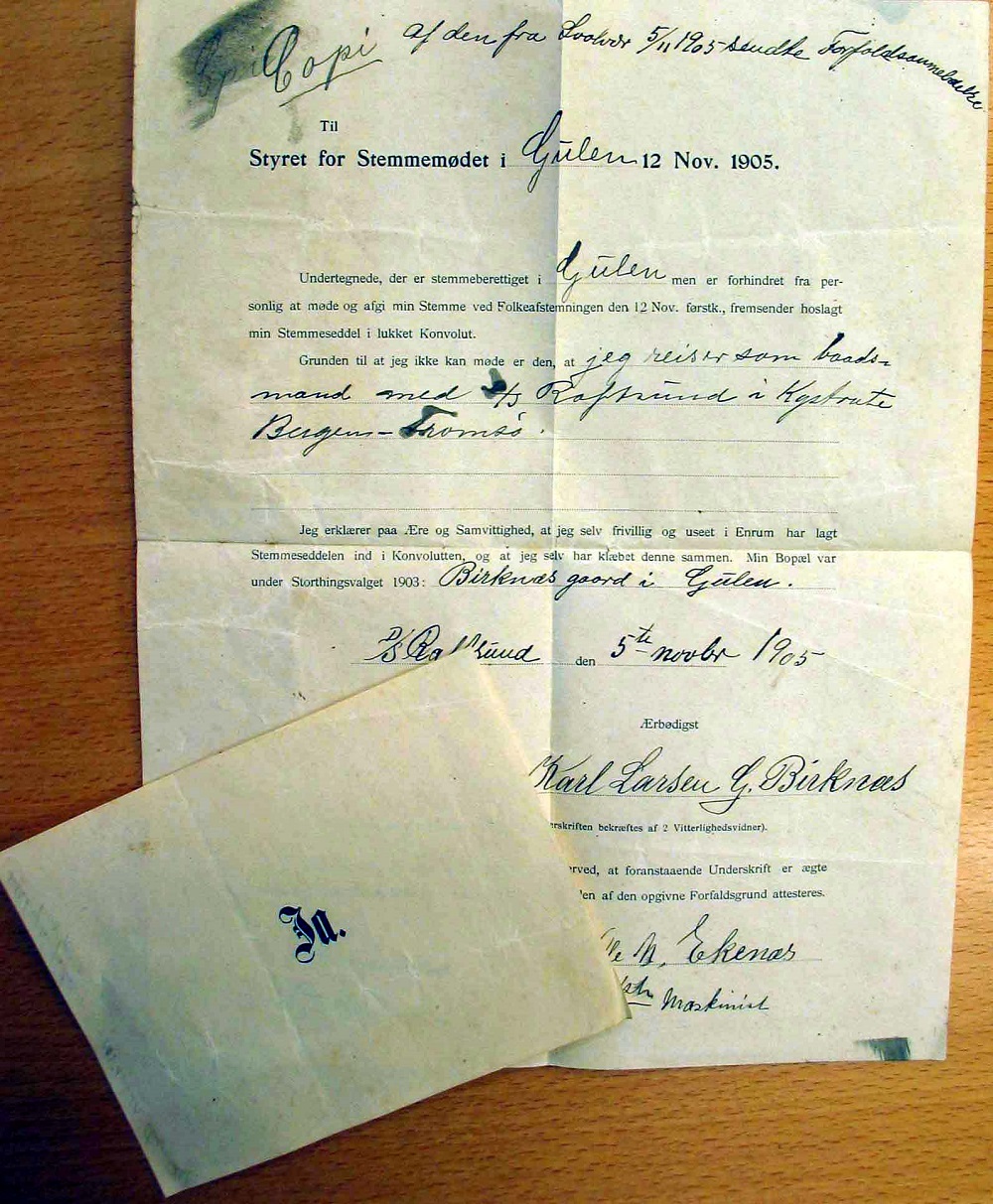
The newspapers in the county reported that the 13 August 1905 was a day of celebration. On 22 August "Sogns Tidene" printed a letter signed by O. W. He wrote that "the church at Eivindvik was decorated for the occasion with flags and plants and branches, which contributed significantly to the festive atmosphere". Furthermore, he wrote that the turnout was very high. After the service the vicar spoke from the chancel doorway. He pointed out "that if there were any Norwegians who voted 'no' to the 7 June resolution, they should be excused for they did not understand what they were doing".
The high turnout at the referendums can partly be explained by the fact that boat owners and steamship companies supplied extra boats so people could be transported to the polling stations. From Gulen the signature O.W. writes in "Sogns Tidende" on 22 August: " .. and many thanks also to the "N. B. Amts" steamship company and especially to the captain of S/S "Sogns", Mr Slætten, for his courtesy in taking a number boats and transporting people out to Skjerjehamn and Mjømna."
Private petition campaign by women
Women did not have the right to vote in national elections in 1905. However, they wanted to be allowed to say 'yes' along with the men. A number of women's organizations joined their efforts in organizing a countrywide petition campaign, and on 22 August, they delivered some 250,000 signatures to the Storting.
In "Sogns Tidende" on 9 August there was a printed appeal from Mrs Prime Minister Qvam to women to sign petition lists. Newspapers were important instruments in providing information on the campaign, and even though we do not have much information about the women's campaign in Gulen, it is not unlikely that also women from Gulen signed their names on these petition lists.
Referendum in November - monarchy or republic
The result of the November referendum for the Gulen election district: Of 669 who had the right to vote, 494 cast their votes (73.24%). Four votes were not accepted. 426 voted 'yes' (for monarchy), 64 voted 'no' (for republic).
The result of the November referendum for the Lavik election district: Of 809 who had the right to vote, 495 voted (60.19%). Eight votes were rejected. 290 voted 'yes', 197 voted 'no'.
(For this referendum we do not have separate figures for Brekke.)
The result for the county of Sogn og Fjordane: 18,278 had the right to vote, and the number of accepted votes was 14,315 (78.3 %). 11,507 (80.4%) voted for monarchy, 2,808 (19.6%) voted for republic.
The result for the whole country: 331,833 had the right to vote, and the number of accepted votes was 244,124(73.5%). 194,189 (79.5%) voted for monarchy, 49,935 (20.5%) voted for republic.
The new royal family
On 18 November, the Storting chose Prince Carl of Denmark as King of Norway. He was married to Princess Maud from England, and they had a son named Alexander. Prince Carl took the name Haakon VII and the son Alexander got the new name Olav. The new royal family came to Kristiania (Oslo) on the Norwegian naval vessel "Heimdal" in the evening of 25 November, where they were met by a huge and festive crowd.
The seaman Karl Gåta from Byrknesøy in Gulen was in Bergen on the day when the royal family came to Norway. His diary for that day had the following entry: "25/11: Bergen (The royal day). The whole day the town and the steamers were nicely decorated with flags of all possible sizes wherever one looked.
The words: 'All for Norway' (King Haakon VII's motto) was illuminated at the Triangelen and printed in all the windows, along with pictures of the royal family and Prime Minister Michelsen, decorated with national colours and greenery. There were throngs of people wandering about in the streets in the evening. At 10pm the torchlight procession - the first one I have ever seen - marched from Festningen along Øvregate and down along the tram line across the marketplace to the statues of Holberg and Christie."
"Celebrations on the occasion ¿ of the conclusion of the liberation efforts"
Many places throughout the country celebrations were organized in December to mark the eventful year of 1905.
On 7 December, a special thanksgiving service was held at Gulen church to mark the political liberation of the country. We have no further information about this service, but according to the circular from the Ministry of Church Affairs, the sermon would be based on Psalms, 118:23-26, and it was recommended to use the national hymn by Blix.


